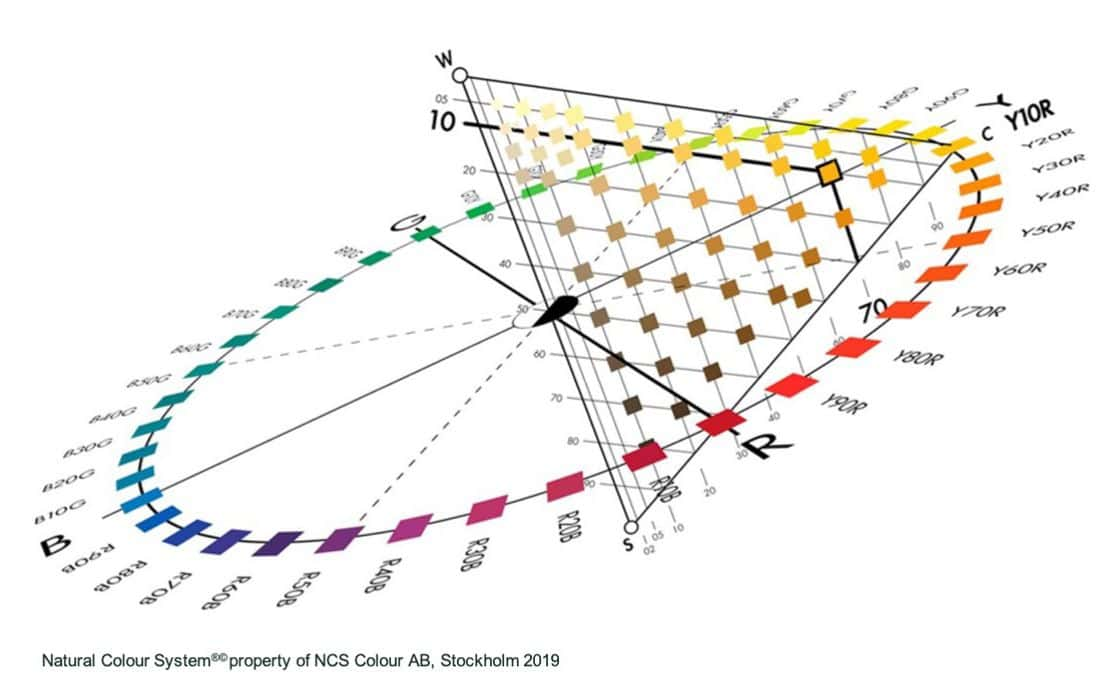UNDERSTANDING NCS
The Natural Colour System is a scientifically based colour system that allows for accurate cross-industrial colour communication, based on how we perceive colour visually.
NCS goes from 1950 to 2050 Standard colours
Low chromatic colours are extremely important in interior design, product design and architecture..
However, slight differences in nuance or hue can make a major impact on the final design.
For this reason, we are making the Standard range of colours denser in the low chromatic area of the colour space.
The new colours are low chromatic nuances with focus on hues between Yellow and Red.
Two completely new nuances are added, NCS S 0601 and NCS S 1001, often referred to as off-white.
These 100 new colors have never existed before in the NCS Standard color range.

COLOUR PERCEPTION
The eye contains cells of three different types, sensitive to thereddish, greenish and bluish part of the light.
Our eyes interpret color according to two signals of opposite colors
- Red vs. Green
- Blue vs. Yellow
We cannot perceive a bluish-yellow or a reddish-green colour.
White and Black are handledby a third signal, lightness.

ELEMENTARY COLOURS
The Natural ColourSystem is based on the six elementary colours which are perceived by human beings as being “pure”. E.g. pure green is not perceived to be bluish or yellowish, nor is pure yellow perceived to be greenish or reddish.
The two achromatic colours are; white (W) and black (S).
The four chromatic colours are; yellow (Y), red (R), blue (B) and green (G).
We can describe all 10 million colours that we can perceive with the six elementary colours.

NCS COLOUR SPACE
NCS – Natural Colour System is illustrated in a three-dimensional colour space.
Within this three-dimensional model all imaginable surface colours can be plotted and given a NCS Notation.

NCS NOTATION
NCS defines all imaginable surface colours with a corresponding NCS Notation.
The first S means that the colour is one of the NCS 2050 Standard Colours.
The following numbers are the percentage of Blackness and Chromaticness; the Nuance of the colour.
The end is the hue, the position in the colour circle, of the color.

NCS Colour Circle: Hue
The NCS Colour Circle is a horizontal section through the middle of the NCS Colour Space.
The hue is described as the relation to one or two of the four chromatic elementary colours in the colour circle.
The four elementary colours; yellow, red, blue and green are situated in the circle with equal distance between them, defining all possible hues. For each 10th hue step there are standardised colours.
NCS always describes the elementary colours in the hue clock wise; from Y to R to B to G and to Y again.
EXAMPLE
- Y10R is a Yellow with 10% Red
- B50G is a Blue with 50% Green

NCS COLOUR TRIANGLE: NUANCE
The NCS Colour Triangle is a vertical section through the colour space.
For each hue in the NCS Colour Circle there is one NCS Colour Triangle.
The base of the triangle is the axis, from white to black, and located vertically on the left side.
The tip of the triangle, to the right, is the most chromatic colour of this hue.
The scale from white to black is the percentage of blackness (s). The scale from the base of the triangle to the most chromatic colour is the percentage of chromaticness (c). The nuance describes each unique point in the triangle and is the combination of the whiteness (w), blackness (s) and chromaticness (c). The Nuance is always 100% i.e. w+ s + c = 100%.
EXAMPLE
The colour 1070-Y10R has the nuance 1070, i.e. 10% in blackness and 70% in chromaticness. The whiteness is then100%-10%-70% = 20%

